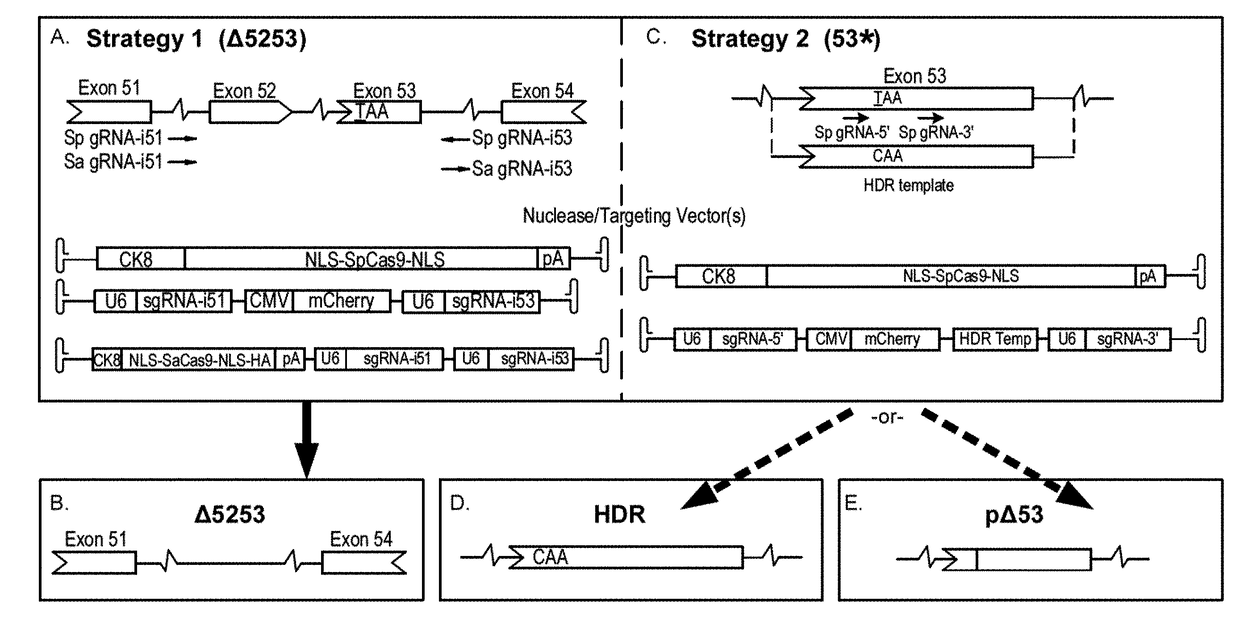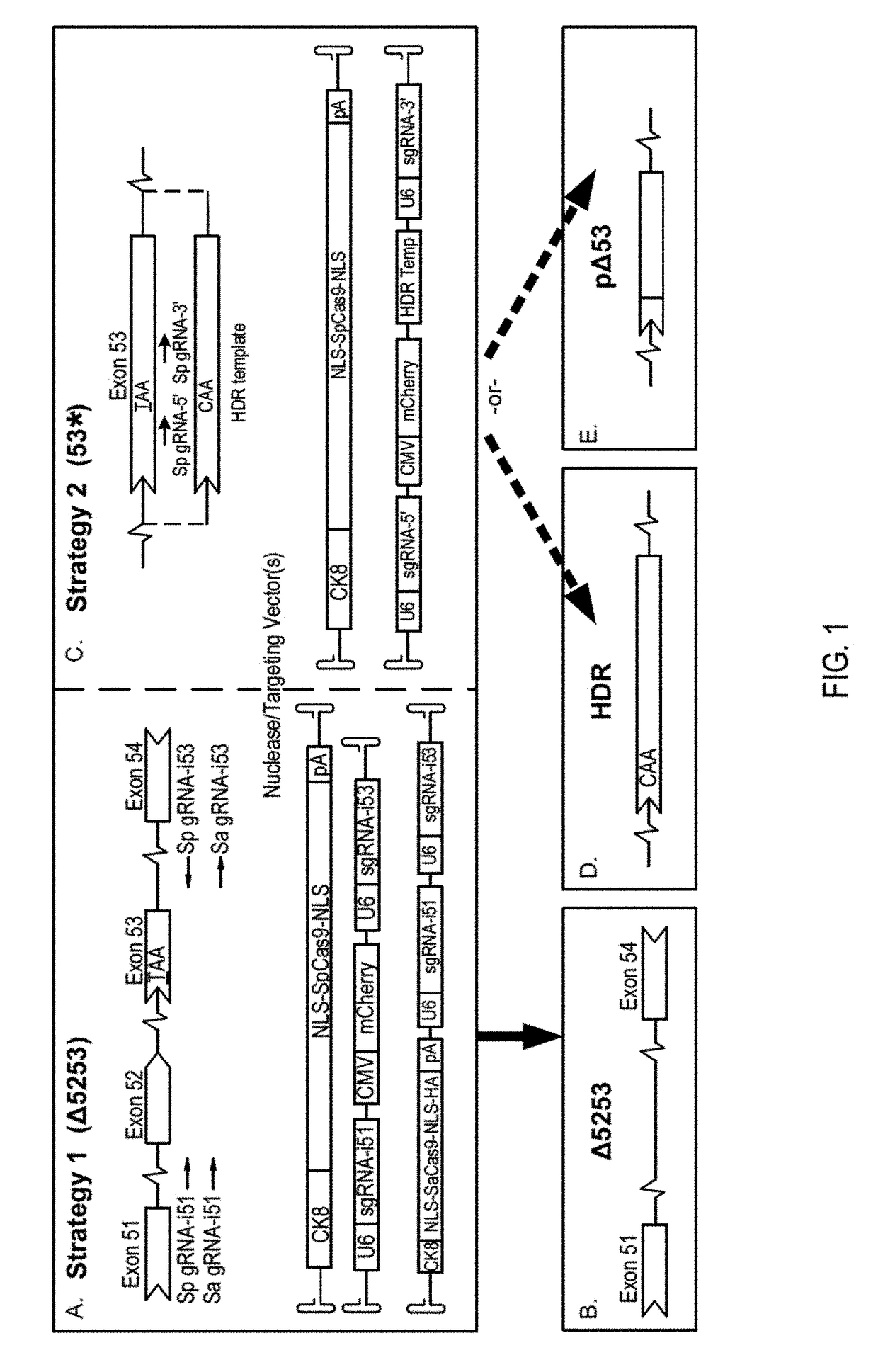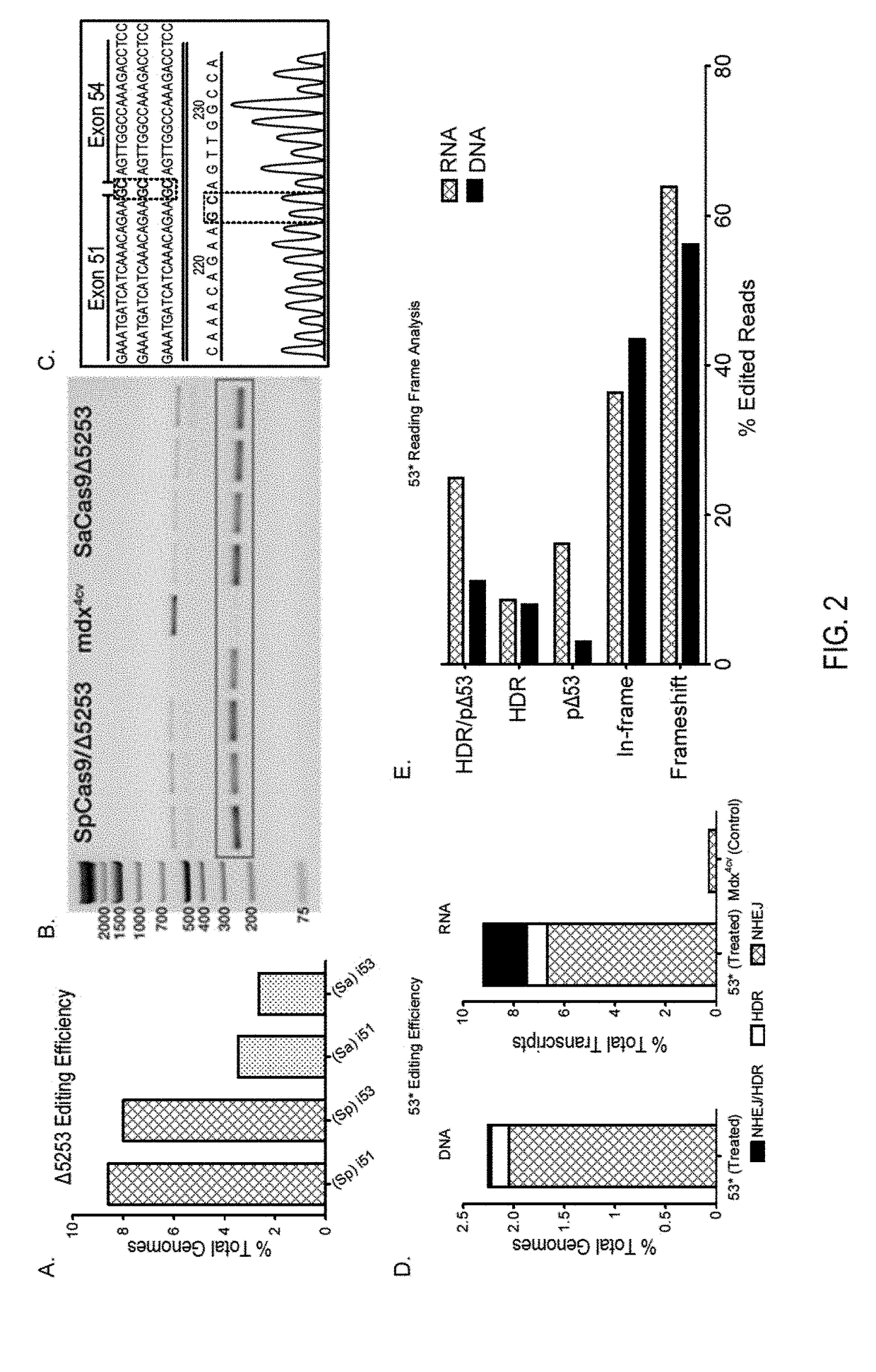Muscle-specific crispr/cas9 editing of genes
a gene and muscle technology, applied in the field of pharmaceutical compositions, can solve the problems of large flexibility in the strategy of applying gene editing to the dystrophin gene, the episomal aav vector could be gradually lost during normal myofiber turnover, and the microdystrophin is not fully functional
- Summary
- Abstract
- Description
- Claims
- Application Information
AI Technical Summary
Benefits of technology
Problems solved by technology
Method used
Image
Examples
example 1
Cloning and Vector Production
[0071]Plasmids containing regulatory cassettes for expression of Cas9 or gRNAs flanked by AAV serotype 2 inverted terminal repeats (ITRs) were generated using standard cloning techniques. The spCas9 nuclease expression cassette was generated by PCR cloning of NLS-SpCas9-NLS from LentiCRISPRv1 (see Shalem, O., et al. Science 343, 84-87 (2014)), and insertion into pAAV (STRATAGENE™) containing the ubiquitous elongation factor-1 alpha short promoter (EFS) (id.) (for in vitro studies in fibroblasts) or the muscle-specific creatine kinase 8 (CK8) regulatory cassette (RC) (see Himeda, C. L., et al. Methods Mol. Biol. 709, 3-19 (2011) and Hu, C., et al. Mol. Ther. 22, 1792-1802 (2014)) (for in vivo studies). (Sp)sgRNA target sequences were selected using the online software ZIFIT TARGETER™ (http: / / zifit_partners_org / ZiFiT / ) and inserted into pLentiCRISPRv1 following BsmB1 restriction enzyme digestion. Two targeting constructs to work in conjunction with SpCas9 ...
example 2
Electroporation and Culture of Primary Dermal Fibroblasts
[0072]Primary dermal fibroblasts were isolated from 3-week-old male mdx4cv mice (see Takashima, A. Curr. Protoc. Cell Biol. 2.1, 2.1.1-2.1.12 (2001)). Electroporation of ˜600,000 cells per strategy were performed in INVITROGEN™ R-buffer containing 4 μg of both nuclease (EFS-SpCas9) and targeting (Δ5253 / 53*) plasmid expression constructs using a NEON® transfection system (INVITROGEN™) with three 10 ms pulses of 1,650 volts. Cells were subsequently seeded on 0.1% gelatin-coated culture vessels and maintained for 12 days in Dulbecco's modified Eagle medium supplemented with Penicillin-Streptomycin, Sodium pyruvate, L-Glutamine and 15% fetal bovine serum (THERMO FISHER SCIENTIFIC™) before harvest and DNA isolation (DNEASY° , QIAGEN™)
example 3
Animals
[0073]All animal experiments were approved by the Institutional Animal Care and Use Committee of the University of Washington. Intramuscular delivery of 2.5-5×1010 v.g. of each vector (nuclease and targeting) was performed via longitudinal injection into tibialis anterior (TA) muscles of 2-12-week-old male C57BL / 6-mdx4cv (mdx4cv) mice. For strategy 1, systemic delivery of 1×1012 v.g. (low dose) to 1×1013 v.g. (high dose) was performed via retro-orbital injection into 11 week-old male mdx4cv mice (n=3). Both dual- and single-vector approaches were evaluated at the low dose of 1×1012 v.g. of each vector, while the dual-vector approach was also evaluated at a high dose of 1×1013 v.g. of the nuclease vector and 4×1012 v.g. of the targeting vector. The mdx4cv mouse model of DMD harbors a nonsense C to T mutation in exon 53 leading to a loss of dystrophin expression (see Im, W. B., et al. Hum. Mol. Genet. 5, 1149-1153 (1996)). These mice exhibit ˜10-fold lower frequencies of revert...
PUM
| Property | Measurement | Unit |
|---|---|---|
| volume | aaaaa | aaaaa |
| pharmaceutical composition | aaaaa | aaaaa |
| specific-force generating capacity | aaaaa | aaaaa |
Abstract
Description
Claims
Application Information
 Login to View More
Login to View More - R&D
- Intellectual Property
- Life Sciences
- Materials
- Tech Scout
- Unparalleled Data Quality
- Higher Quality Content
- 60% Fewer Hallucinations
Browse by: Latest US Patents, China's latest patents, Technical Efficacy Thesaurus, Application Domain, Technology Topic, Popular Technical Reports.
© 2025 PatSnap. All rights reserved.Legal|Privacy policy|Modern Slavery Act Transparency Statement|Sitemap|About US| Contact US: help@patsnap.com



